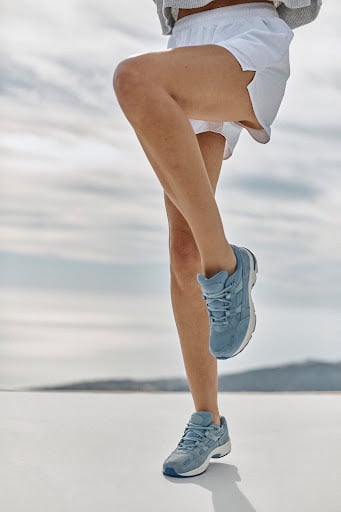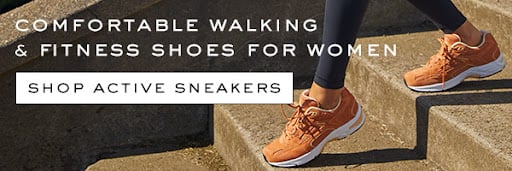When it comes to exercise, there are many of us who are drawn to running for the pure simplicity of the form. Unlike cyclists, who must amass a variety of technical equipment before turning the first pedal stroke, or swimmers, who require access to a pool or swimming hole, all a runner needs to do is pull on their shoes and step out the door.
Speaking of shoes, however, it’s worth noting there’s more than meets the eye. Beneath the laces lies a complex array of ever-evolving technologies designed to keep you comfortable and injury-free.
Navigating the world of running shoes can feel like a walk in the park, but if you aren’t familiar with the different parts and features, or shoe terminology in general, you’ll soon find yourself off the path. That’s why it pays to read up on the anatomy of a running shoe before buying your next pair.
Below, we’ll step through the basic parts, before providing more tips to help you choose the right shoe for you.
Shoe Anatomy Lesson 1: Upper
The upper, or the entirety of the shoe that wraps around the foot and attaches to the sole, is the most visible part of a sneaker and is usually made from fabric or a soft material for comfort and breathability. While much of the shoe choosing process is determined by what sole is right for you—more on that below—different uppers come with a variety of features that may or may not be more suitable for your needs. Look for technical aspects like:
- Waterproof materials or seam-sealed technology, for locking moisture out.
- Lightweight mesh or polyester, for comfort and coolness.
- Sweat wicking fabrics, for blister-free bliss.
Of course, when it comes to picking a shoe, comfort and support trump aesthetics every time. But that doesn’t mean you can’t turn over the miles in style. Chunky contours and drab designs have given way to slim fits and chic colorways—great news for the fashion forward runner or walker.
Shoe Anatomy Lesson 2: Toe Box
While usually part of the upper, the toe box is worth mentioning because it plays a key role in your daily comfort and the long-term health of your feet. According to the American Academy of Orthopaedic Surgeons, tight running or walking shoes put your toes at risk of problems like:
- Bunions
- Corns
- Hammer toes
- Ingrown toenails1
Here, size matters. Look for a shoe with plenty of wiggle room in the toe box. Keep in mind that running increases blood flow down below, resulting in swollen feet.2 To counteract this problem, ensure a half inch of space between your big toe and your shoe.
Shoe Anatomy Lesson 3: Heel Counter
Make your way toward the back of the shoe, and you’ll encounter the heel counter: the part that wraps around the back of the heel. While the uppers are often designed with flexibility and breathability in mind, the heel counter is supposed to be more rigid and inflexible, because it’s meant to stabilize the back of the foot.
Shoe Anatomy Lesson 4: Outsole
The outsole is the part of your shoe that comes into contact with the ground and is usually made of rubber. Just as the tires of your car need plenty of tread to maintain their grip on uneven, wet, or gravelly roads, so is the outer sole designed to keep you upright, even when the road turns rocky.
Shoe Anatomy Lesson 5: Midsole
So, what are midsoles, exactly? Sandwiched between the outsole and the rest of the shoe is the midsole—that springy section of foam that keeps you running on cloud nine instead of crashing into contact with the ground. Without the midsole, there wouldn’t be much absorbing the shock of your footfall.
The midsole can range in softness from extremely pillowy to super firm. Thicker, marshmallowy midsoles provide more cushion, which can feel comfortable for feet adapting to the stresses of running. While some studies have drawn a connection between thicker midsoles and an increased impact on your legs, some runners simply prefer the feel of thicker shoes.3
When you shop for running shoes or even travel walking shoes, much of the conversation around the different pairs will focus on this part of the sole. That’s because the midsole dictates the overall “ride” of the shoe, or factors such as:
- How stable the shoe feels
- How much cushioning the shoe has
- How supportive the shoe is
The midsole is also where shoe manufacturers make small adjustments to provide more or less stability to counteract the effects of overpronation. This is why the midsole of the shoe is the heart of the shoe.
But wait—what’s overpronation? And what can shoe-wearers do about it?
Choosing Running Shoes for Your Natural Gait
If you’ve researched running shoes, you’ve probably come across the term pronation. This refers to the natural process of how your foot rolls inward as it strikes the ground, during which your arches flatten a bit to absorb the shock.4
Everyone pronates a little bit, but overpronation has been linked to issues that might inhibit your exercise routine, such as:
- Shin splints
- Heel pain
- Achilles tendonitis
- Plantar fasciitis
- Hip pain
- Iliotibial band syndrome5
In an effort to prevent these sidelining conditions, most running shoe manufacturers split their running shoes into two categories: neutral and stability.
Neutral Running Shoes
Shoes that are neutral have little to no support designed to control excessive pronation of your foot. Now, this is a little confusing—all shoes have some support, otherwise what is that midsole for? Here, support usually refers not to the cushioning in your shoe but the technological features that are added within the midsole to control or “correct” your gait.6
Stability Running Shoes
In contrast, shoes for overpronators have stability features within the midsole or arch area designed with injury avoidance in mind. Some examples of these features include:
- Medial posts – A firm, dense section of material embedded in the midsole to reduce or prevent excessive pronation.
- Heel cup support – Noted above, the heel counter is specifically designed to be more rigid than the rest of the upper. When it comes to stability shoes, manufacturers sometimes beef up the support even more to influence your gait.
- Widened sole – Some running shoes feature a much broader sole to prevent shaky landings and rolled ankles.
Motion Control Running Shoes
Motion control shoes take things a step further, with even more support for those who severely overpronate or who have flat feet. These shoes are fairly inflexible and may clock in at heavier weights, thanks to their denser midsoles or wider platforms.
Does Your Shoe Type Make a Difference When It Comes to Preventing Injuries?
The division between neutral and stable shoes has been an important topic within the shoe industry for years. At the same time, questions continue in the medical field about whether this categorization really makes a huge difference in whether you ultimately end up hobbling with pain or having to sit out your workout sessions.
In one recent study, scientists showed that middle-aged and older people benefited from using more minimal shoes, or shoes with fewer stability features.7 However, a different study concluded that motion control shoes helped female pronating runners maintain low-impact strides, which theoretically could reduce injuries.8
The scientific debate behind shoe types may still be ongoing, but the good news is that most people don’t have to overthink this question. Shoes designed with stability features may have a noticeable impact on how fast your feet fatigue, how solid your stride feels, and how comfy the shoe is. Others may prefer the relative light weight of neutral shoes, or the fact that they can feel the ground beneath their feet a little better without a dense, chunky midsole.
3 Features to Consider in Your Next Pair
Choosing a shoe shouldn’t be complicated. Here’s a short list of features to look for that keep your whole body in balance and alleviate aches and pains.
#1 Look for Arch Support
As noted above, your foot arch naturally flattens as part of your stride, which may be more or less of a good thing depending on how much you pronate. Arch support can also support proper foot alignment, leading to better movement from your ankles to your hips and back.
#2 Seek Out Cushioning
How much pillowy pleasantness you need is a matter of personal preference. That said, cushioning protects your feet from the shock of hammering trails and concrete—and it doesn’t feel as rough, either.
#3 Find Flexibility
A shoe with some flexibility allows your foot to proceed naturally through the gait cycle, ensuring the right amount of movement in the forefoot and keeping you nimble on your feet.
Choose Vionic for Your Next Pair
Running shoes are the stallions of the shoe world, designed for speed and swiftness. This is why you’ll often see high-performance running shoes on the feet of walkers—because they look great and often feel great, too.
While it’s totally acceptable to use athletic shoes for sauntering and strolling, those who walk for exercise can also benefit from a shoe designed with walkers in mind. The basic anatomy—from upper to outsole—will remain the same but may include small design tweaks tailored for your optimal stride.
At Vionic, we’re focused on ensuring your comfort and supporting your stride, no matter how you prefer to move. Designed with our exclusive VIO MOTION™ technology, Vionic active shoes are podiatrist-approved and help to keep your body in balance. Check out our lineup today.
Sources:
- “Tight Shoes and Foot Problems.” OrthoInfo. https://orthoinfo.aaos.org/en/diseases–conditions/tight-shoes-and-foot-problems/
- “Why Do Runners Get Swollen Feet?” Runner’s World. https://www.runnersworld.com/health-injuries/a31139613/swollen-feet/
- Kulmala, Juha-Pekka et al. “Running in highly cushioned shoes increases leg stiffness and amplifies impact loading.” Scientific reports vol. 8,1 17496. 30 Nov. 2018, doi:10.1038/s41598-018-35980-6
- Sánchez-Rodríguez, Raquel et al. “Modification of Pronated Foot Posture after a Program of Therapeutic Exercises.” International journal of environmental research and public health vol. 17,22 8406. 13 Nov. 2020, doi:10.3390/ijerph17228406
- “Overpronation.” Cleveland Clinic. https://my.clevelandclinic.org/health/diseases/22474-overpronation
- Canter, Lily. “What is a neutral shoe – and who needs them for running?” LiveScience. 26 June, 2022. https://www.livescience.com/what-is-a-neutral-shoe
- Cudejko, Tomasz et al. “Minimal footwear improves stability and physical function in middle-aged and older people compared to conventional shoes.” Clinical biomechanics (Bristol, Avon) vol. 71 (2020): 139-145. doi:10.1016/j.clinbiomech.2019.11.005
- Jafarnezhadgero, Amir Ali et al. “Motion-control shoes help maintaining low loading rate levels during fatiguing running in pronated female runners.” Gait & posture vol. 73 (2019): 65-70. doi:10.1016/j.gaitpost.2019.07.133



Leave a Reply